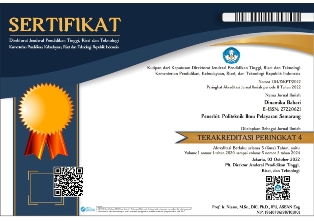Analysis of Determination of Sea Toll Routes in Eastern Indonesia (KTI) Using Dynamic Programming
Abstract
The sea highway program is part of the fourth pillar, namely the pillars of the maritime economy, infrastructure and increasing welfare, one of the seven pillars of Indonesia's Maritime Policy (KKI). The aim of the Sea Highway Program is to grow the maritime economy by turning the sea into a production and marketi ng center between the Indonesian territory and the islands and surrounding areas. This study aims to analyze the decision of maritime highway routes in Eastern Indonesia Region (KTI) in order to provide the best route with a minimum distance. Four shipping highway routes from Surabaya to Eastern Indonesia Region, namely route T-13 (Tanjung Perak-Rote (Ndao)-Sabu (Biu)-Tanjung Perak), T-14 (Tanjung Perak-Lembata (Lewoleba)-Tabilota/Larantuka- Tanjung Perak), T-15 (Cape Perak-Makassar (Soekarno Hatta)-Jailolo-Morotai (Daruba)-Tanjung Perak), and T-18 (Tanjung Perak-Badas-Bima-Merauke (Kelapa Lima)-Tanjung Perak) combined into 1 (one) route from Tanjung Perak to Merauke, resulting in 1 (one) optimal route with the minimum distance obtained from the smallest value at each stage . This study uses quantitative methods and Multistage Graph problem-solving techniques with Dynamic Programming backward or bottom-up methods, and primary data collection through interviews and secondary data such as: documents/journals/books. The selected optimal route is (Tanjung Perak-Makassar-Tabilota/Larantuka-Sabu (Biu)-Merauke (Kelapa Lima)) with a distance from Tanjung Perak to Makassar is 437 Nm. Makassar to Tabilota/Larantuka is 340 Nm. Tabilota/Larantuka to Sabu (Biu) is 163.8 Nm. Sabu (Biu) to Merauke (Kelapa Lima) is 1261.24 Nm. So that the total shipping distance from Tanjung Perak to Merauke is 2202.04 Nm.
Downloads
References
Directorate General of Sea Transportation, Ministry of Transportation of the Republic of Indonesia. (2020). Sea Highway Connectivity Vision of the Indonesian Maritime Axis.
Jumadi, J. J. (2014). Penentuan Rute Terpendek Menuju Kampus Menggunakan Algoritma Dynamic Programming. Jurnal Istek, 8(1).
Kamalanathsharma, R. K., & Rakha, H. A. (2013, October). Multi-stage dynamic programming algorithm for eco-speed control at traffic signalized intersections. In 16th International IEEE Conference on Intelligent Transportation Systems (ITSC 2013) (pp. 2094-2099). IEEE.
Kurniawan, R. (2022). Analisis Dampak Ekonomi Dari Implementasi Kebijakan Tol Laut di Wilayah Timur Indonesia: Sebuah Tinjauan Literatur.
Kusuma, L. T. W. N., & Tseng, F. S. (2019). Analysis of the impact of the “sea toll” program for seaports: Resilience and competitiveness. Applied Sciences, 9(16), 3407.
Ministry of Defense of the Republic of Indonesia. (2015). Indonesian Defense White Paper. [Ebooks].
Nicholson, T. A. J. (1966). Finding the shortest route between two points in a network. The Computer Journal, 9(3), 275-280.
Regulation of the President of the Republic of Indonesia No. 16 of 2017 concerning Indonesian Maritime Policy.
Regulation of the President of the Republic of Indonesia No. 34 of 2022 regulates the 2021-2025 Indonesian Marine Policy Action Plan.
Sari, N. I. (2020). Penentuan Rute Terpendek Pendistribusian Produk Kue Dengan Menggunakan Algoritma Dynamic Programming Pada Pabrik Kue Ima Brownies (Doctoral dissertation, Universitas Islam Negeri Sumatera Utara).
Theocharis, D., Rodrigues, V. S., Pettit, S., & Haider, J. (2019). Feasibility of the Northern Sea Route: The role of distance, fuel prices, ice breaking fees and ship size for the product tanker market. Transportation Research Part E: Logistics and Transportation Review, 129, 111-135.
Zaccone, R., Ottaviani, E., Figari, M., & Altosole, M. (2018). Ship voyage optimization for safe and energy-efficient navigation: A dynamic programming approach. Ocean Engineering, 153, 215-224.
Zhang, Y., Meng, Q., & Ng, S. H. (2016). Shipping efficiency comparison between Northern Sea Route and the conventional Asia-Europe shipping route via Suez Canal. Journal of Transport Geography, 57, 241-249.
Zhao, H., & Hu, H. (2016). Study on economic evaluation of the Northern Sea Route: Taking the voyage of Yong Sheng as an example. Transportation Research Record, 2549(1), 78-85.
Zhao, H., Hu, H., & Lin, Y. (2016). Study on China-EU container shipping network in the context of Northern Sea Route. Journal of Transport Geography, 53, 50-60.














